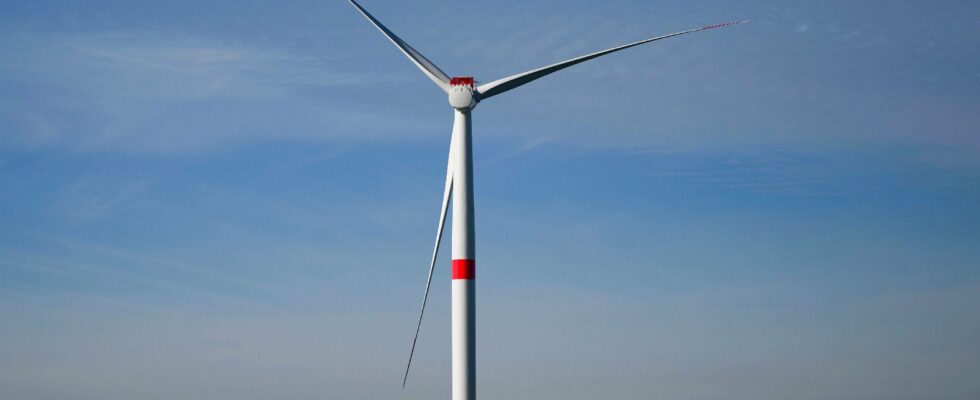Since June 9 and the dissolution of the National Assembly by Emmanuel Macron, the world of wind power has been shivering. The National Rally’s score, and the prospect of a far-right majority in Parliament, leaves this industrial sector, although accustomed to political upheavals, in suspense.
What should we understand about Marine Le Pen’s proposal to establish a moratorium on “intermittent” renewable energies? Should we believe her when she talked about dismantling the wind farms in 2022? And what would happen to future calls for tenders for the long-awaited large offshore parks? Faced with these proposals, those responsible for the sector hesitate between disbelief and concern. “We look at what’s happening very closely, but we don’t have a crystal ball, so we don’t want to cry before it hurts,” explains the director of an energy company.
Burdened with all the evils, considered “ugly”, “useless” and too expensive because they are too “subsidized”, wind turbines have been the subject, in recent years, of a particularly offensive campaign from the far right. And if the party seems to have watered down its wine on the acceptance of some production sources such as geothermal or biomass, mast-mounted turbines remain in the viewfinder.
Questioned by L’Express on the reality of the National Rally program, outgoing MP Jean-Philippe Tanguy is direct. “On wind power, we stop everything,” he says straight away, before introducing some nuances into this radical strategy. “We are not dismantling the existing wind turbines, we plan not to renew the current concessions,” he explains. “A few” units could however be dismantled on “historic or remarkable sites”, announces the party’s economic expert, taking the example of the Fécamp cliffs.
A stop?
This policy change would be a real turning point for the renewable energy sector. Last year, wind energy represented just over 10% of total electricity production in France. It is also an area where government ambitions are strong. The multi-year energy programming law, signed in 2019, provides for a doubling of current production capacities by 2028. A horizon which should allow France to diversify its energy mix and ensure the production of electrons while nuclear power is gaining momentum. “If we want to continue on a trajectory of decarbonization and reduce our energy dependence, we know the solutions, it involves more renewable energies, and therefore wind turbines”, underlines Jules Nyssen, the president of the Renewable Energies Union .
Energy companies, builders, or project developers are worried about seeing this long-awaited dynamic suddenly slow down. “There are many questions being asked about the current calls for tenders, and in particular about the famous 10 gigawatt wind farm which had been postponed many times but which was finally planned for the end of 2025”, we underline within an energy group.
For the moment, the National Rally appears vague. Large wind farms located at sea could continue if their shutdown costs too much legally, warns the RN deputy, but for the approximately 10,000 units located on land, the arrival of the extreme right in government would put a certain stop to it. . An observation which is of little concern to large players, whose strategy is centered on diversification and international development, but which would directly impact the smaller structures which have chosen to concentrate on the onshore wind turbine segment. “These small French players would be the first to be affected because 90% of their activity is in France,” we point out within a heavyweight in the sector.
Job fears
With its vast maritime facades, France represents the second largest wind potential in Europe, after that of Great Britain. According to France Renouvelables, which represents the sector, a third of the industrial capacity of European offshore wind turbines is located in France. The manufacturer Siemens-Gamesa is based in Le Havre to build blades and nacelles, while the American General Electric Renewable has set up in Montoir-de-Bretagne (Loire-Atlantique) and Cherbourg (Manche). “France has become the rear base for the development and deployment of offshore wind power in Europe because the companies which invested here believed in the trajectory and ambition displayed by the country. If there is no longer prospects, I don’t know if the owners of these factories will keep them in France”, assures Jules Nyssen.
Within GE Renewable, already in the midst of reorganization, employee fear is palpable. Because the sector, affected by an increase in material costs and the difficulty of achieving national ambitions, is slowing down. “A moratorium would signify the end of calls for tenders for new parks, and therefore the end of the market in France. And if there is no longer a market, there is no longer any justification for GE Renewable to keep its factories here,” confirms a union official from the company.
On the side of the National Rally, this hypothesis is considered, and even assumed: “We need qualified worker jobs for other sectors. If these companies want to build offshore wind turbines in other European countries, so much the better, but the French market will no longer offer them any outlets,” warns Jean-Philippe Tanguy. “The possibility of a moratorium poses a risk to the renewable energy sector, in France but also in Europe. It would be the first time that a government would decree a social plan on such a scale,” underlines Mattias Vandenbulcke, director of strategy at France Renouvelables.
In the meantime, players in the sector are studying possible political scenarios and trying to estimate the room for maneuver that the RN will have in Parliament. “We are doing a lot of statistical analysis work, we are looking at the constituencies, to try to have an image of the majority, absolute or relative, which will emerge,” confirms a manager. Without knowing to this day whether or not the wind is likely to change.
.
